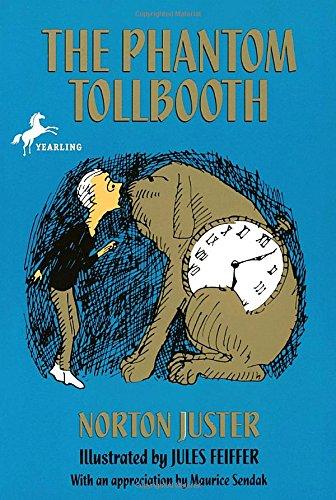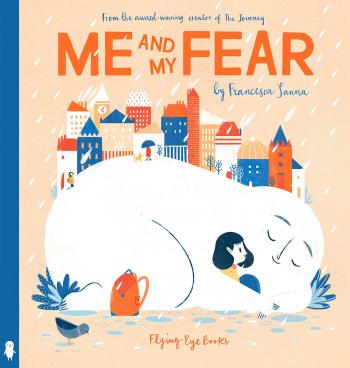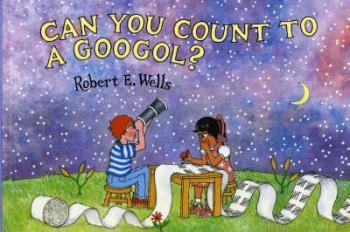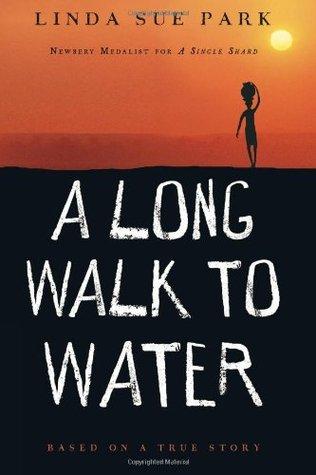
scrounge: /skrounj/ informal verb: to actively seek [books] from any available source

I decided that a blurb in my 2017 round-up post did not do The Phantom Tollbooth justice, so I'm writing up an expanded review all of its own.
I'd heard of this book for a while before reading it, but the title led me to assume it was some kind of ghost story. It's not -- it's basically a geek's paradise -- full of word play, fun with mathematics, etc. Have you ever wondered what it would be like if music had colors -- like if an orchestra played the sunrise? Or what it would be like to collect sounds, or eat letters? Or what a world without sound would be like? (At times this is basically "Synesthesia: The Novel.")
The story revolves around a boy named Milo who is simply bored and lethargic all the time. But when he receives a strange tollbooth in a box, he finds a portal to a land full of interesting places and eccentric characters -- for example, there's a witch who's actually a "Which," a "Whether Man," a Mathemagician, as well as King Azaz the Unabridged, all with something to teach him about the value of learning and curiosity.
It's a very fun story, especially the parts that involve word play and puns (which is why I'd much rather read the book myself than have it read to me, and imagine it could be more fun for children to read on their own as well). I suppose this is a book about learning, but also something about how to be wise, or how not to be ignorant, or how/why to pay attention to all that's around you -- in a way it's about educating yourself, but without all the heavy-handed "educational" stuffiness.
Scrounged From: PaperbackSwap.com
Format: Paperback
Author: Norton Juster
Pages: 256
Content Advisory: There are a few scenes of peril, especially toward the end.

I really loved the illustrations in Francesca Sanna's The Journey (which I included in my list of picture books featuring refugees). So when I saw she had a sequel out, I jumped at the chance to read it.
In a way, Me and My Fear picks up where the previous book leaves off -- a girl and her mother and siblings have fled a land of war (there are no national identifiers here in order to apply to the broader refugee experience). Here, she is trying to adjust to a new location where she is unfamiliar with the language and customs of the children around her. But she has a little friend who helps to protect her -- Fear.
I like that fear is occasionally portrayed in a positive light -- able to provide some services that are good, and not as something that has to simply be eradicated from a person's life. But this girl's Fear friend soon grows so large that it keeps her from doing a lot of things. It causes her to feel lonely, anxious, and to engage in negative self-talk.
This is also an interesting picture, as Fear is at once an essential part of the girl, but also something outside of her that she has to contend with when their desires are at odds. I thought the allegory was well done, and portrays this often tempestuous relationship in a believable way.
In the end, one thing that helps the girl to deal with her fear is to recognize that, contrary to what Fear tells her, she is actually not alone -- the children around her all have Fear friends as well, even if they're often smaller than hers. This contrast between loneliness and solidarity was also helpful in understanding fears. I think this book could be very helpful, especially for anxious kids or adults, and even for those who are not trying to make the shift between cultures.
(Thanks to NetGalley for the review copy.)
Scrounged From: NetGalley
Format: Kindle
Author/Illustrator: Francesca Sanna
Pages: 40
Content Advisory: None

A while ago, in this post, I wrote about some titles in Robert E. Wells' science series that we've really enjoyed. We've since read a few more books from this series that we've enjoyed just as much, so I decided we needed a "part two."
The first is Can You Count to a Googol?, which uses creative illustrations and simple mathematical concepts to introduce students to progressively larger numbers -- from one, to ten, to one hundred (with the reminder that each zero at the end makes a number ten times bigger), to even more. The visualizations include baskets full of marshmallows, penguins eating many scoops of ice cream, and dollar bills packed onto pallets. The end blew our minds a bit as we tried to understand just how big a googol is (one with one hundred zeroes after it). Even then, the reminder that numbers never end gives a lot of perspective as we contemplate outer space and other things so much bigger than us. This book is similar to How Much Is a Million?, a memorable Reading Rainbow book, but I appreciate that this one walks us through even larger numbers and is more clear about how to get from one to another.
The next is Did a Dinosaur Drink This Water?, which is a very thorough exploration of the water system (dinosaur-loving kids may be disappointed to find out that this isn't really about dinosaurs, but it does emphasize how water molecules have been recycled over and over for a very long time). Since it mentions water molecules, this might be an interesting follow-up to What's Smaller Than a Pygmy Shrew? It covers fresh vs. salt water, how water is naturally cleaned and filtered, evaporation and rain, hydroelectricity, and also a bit about conservation at the end, which actually follows well from the text and doesn't feel "tacked on" like these things sometimes do.
Lastly, we've also enjoyed How Do You Know What Time It Is?, which is one of the more thorough titles we've read since it covers aspects of both science and history, and it may be harder for younger children to follow. But it does a great job introducting children to the concept of time, and how we don't even really know what it is. The history comes in when it discusses many of the earlier methods that people used to measure time, such as sun dials, water clocks, and solar vs. lunar calendars. From there it goes into earth's rotation and orbit, as well as time zones and other complications of measuring time. I appreciated the science and history, but also the straightforwardness about mystery, and how much science still hasn't been able to tell us about many concepts, such as time.
Scrounged From: Our local library and AbeBooks.com

A Long Walk to Water tells the story of Salva, one of Sudan's "Lost Boys" who is forced to flee his village when violence breaks out. He then spends years walking through Sudan, Ethiopia, and Kenya, crossing rivers and desserts, spending some time in refugee camps just trying to survive. This story is fictionalized, but is based on the actual story of Salva Dut.
This narrative is interspersed with an almost-present-day story of Nya, who has to spend her entire morning walking to find water, and cannot go to school because of this. As the story progresses, these two narratives come together in a hopeful and redemptive conclusion. This book is an important look at some of the human cost in the Sudanese conflict, and brings these stories to life in a way that simple news reports cannot.
Scrounged From: PaperbackSwap.com
Format: Paperback
Author: Linda Sue Park
Pages: 128
Content Advisory: Scenes of violence, though not graphically described, include characters being shot (and shot at), and killed in other ways. Loss, especially of family, is a consistent theme.

Adventures with Waffles is a Norwegian tale by a Norwegian author, all about two children who live next door to each other: Trille and Lena. They are nine years old, and get into all kinds of mischief together, because they are best friends -- or at least, Lena is Trille's best friend, but he often wonders whether or not she is his. Lena is the loud one with crazy ideas, while Trille is more subdued, but he follows through on some craziness of his own.
One of the topics in the story, aside from general mischief and close shaves, is the fact that Lena has no dad, and wants to figure out a way to get one. Another topic is death: Trille's "Auntie Granny" dies, and he struggles with his feelings of missing her. There are a couple very sensitive scenes where he talks about this feelings with trusted adults, and I really liked how he was free to express such things -- especially the scene were his father plays him a new song he wrote called "Sad Son, Sad Dad."
As over-the-top as the adventures sometimes are (though nothing too absurd), it's the realistic relationships and caring family that is really at the heart of this book. As an aside, the way the characters are silhouetted on the cover and on the beginning page of each chapter reminds me a little bit of the illustrations in the Bobbsey Twins books. Though there are no larger illustrations in the book, the chapters are fairly short, making it a good read-aloud for early-elementary-aged children.
Scrounged From: Sonlight
Format: Paperback
Author: Maria Parr
Pages: 240
Content Advisory: A death happens in this story (of Trille's "Auntie Granny," but it is handled sensitively.


